Russia and Belarus Conduct Exercises on the Use of Tactical Nuclear Weapons
 The situation got worse
The situation got worse

Joint exercises by Minsk and Russia on the use of tactical nuclear weapons signal preparation for a new phase of escalation in the Russian-Ukrainian conflict and the imminent entry of the Belarusian army into the war on Moscow’s side.
On May 6, the Russian Ministry of Defense announced: the General Staff of the Armed Forces, by order of Vladimir Putin, will conduct exercises in which the “preparation and use of non-strategic nuclear weapons” will be practiced. The forces of the Southern Military District (SMD) and the Navy, participating in the war against Ukraine, will carry out the training. The Kremlin explicitly stated that the exercises were prompted by Western politicians’ discussions about sending troops to Ukraine.
Speaking at a ceremonial gathering in honor of Victory Day, Lukashenka emphasized that the world has never come so close to the threshold of nuclear war as it is now, and warned Western countries that their capitals are legitimate targets for nuclear strikes in the event of “a decision to start aggression.” Following the Kremlin, the politician announced a sudden inspection of the forces and means of the joint regional troop group, during which the use of non-strategic nuclear weapons will be practiced for the first time. During the inspection, special ammunition will be delivered to missile and aviation military units, and also loaded onto launchers and aircraft.
As Defense Minister Viktor Khrenin immediately explained, this refers to a “sudden inspection of the means—carriers of non-strategic nuclear weapons.” For this purpose, a division of the operational-tactical complex “Iskander” and a squadron of Su-25 aircraft were brought to readiness to perform tasks. During the exercises, it is planned to check the entire cycle—from planning and preparation to strikes with tactical nuclear munitions. The Chief of the General Staff of the Armed Forces of Belarus, Viktor Gulevich, added that as part of the inspection, parts of the aviation forces and means were relocated to a backup airfield. The technical staff followed there as well.
Secretary of the Security Council Alexander Volfovich noted that the inspection is planned against the backdrop of activities related to the use of non-strategic nuclear weapons in Russia—and explained its conduct by the military-political situation around Belarus. The main result of the inspection should be the practical confirmation of the military personnel’s skills in using this type of weapon. According to him, these activities are purely defensive in nature and do not project threats to any state.
Following the statement by Lukashenka after the parade in Red Square on May 9 in Moscow, Belarus and Russia agreed to jointly conduct nuclear exercises. In turn, on May 9, following negotiations with Lukashenka, Putin stated that the day before, he had discussed bilateral relations, the situation “related to the complex events around Ukraine,” “at the line of contact.” The discussion also involved the Russian Minister of Defense Sergei Shoigu and the Chief of the General Staff of Russia Valery Gerasimov. Among other things, the discussion touched on nuclear exercises, as non-strategic nuclear weapons are deployed in Belarus.
In this connection, Putin also invited Lukashenka to participate in one of the stages of the exercise. This time they are conducted in three stages, in the second stage Minsk will join the joint actions. Corresponding instructions to the defense ministries and general staffs of the armies of the two countries have been given; they have begun joint preparation. Additionally, Lukashenka informed his accompanying officials Khrenin, Volfovich, and Gulevich, that the Russian troop grouping at the front lacks the presence of the Belarusian army.
Symbolically, immediately after returning from Moscow, the Chief of the General Staff of the Armed Forces of Belarus, Gulevich, known for his opposition to the participation of the Belarusian army in the war against Ukraine, was sent into retirement.
Subscribe to our newsletter




Situation in Belarus
Constitutional referendum: main consequences


 Video
Video
How to count the political prisoners: are the new criteria needed?


 Video
Video
Paternalism In Decline, Belarusian Euroscepticism, And The Influence Of Russia


 Video
Video












